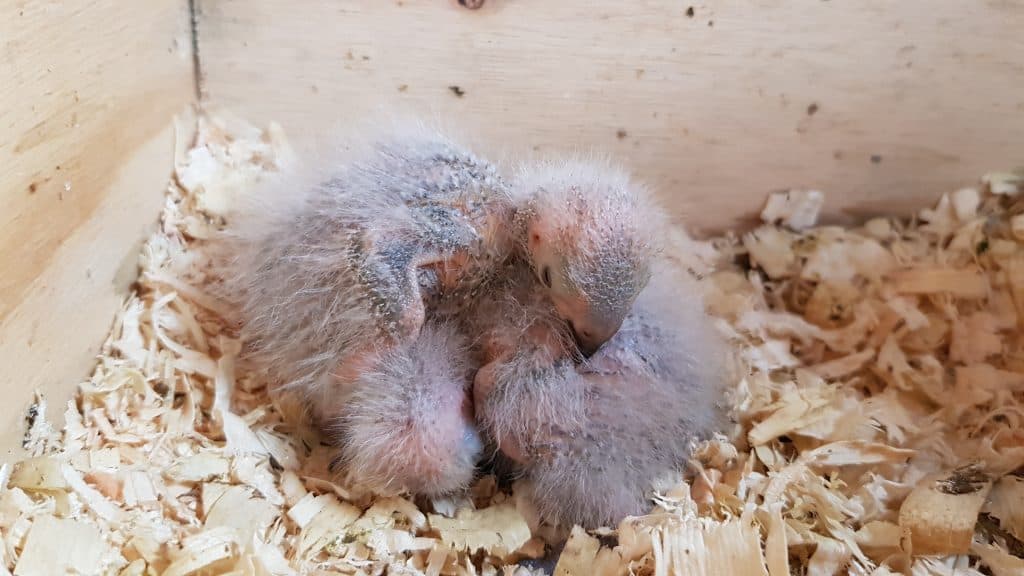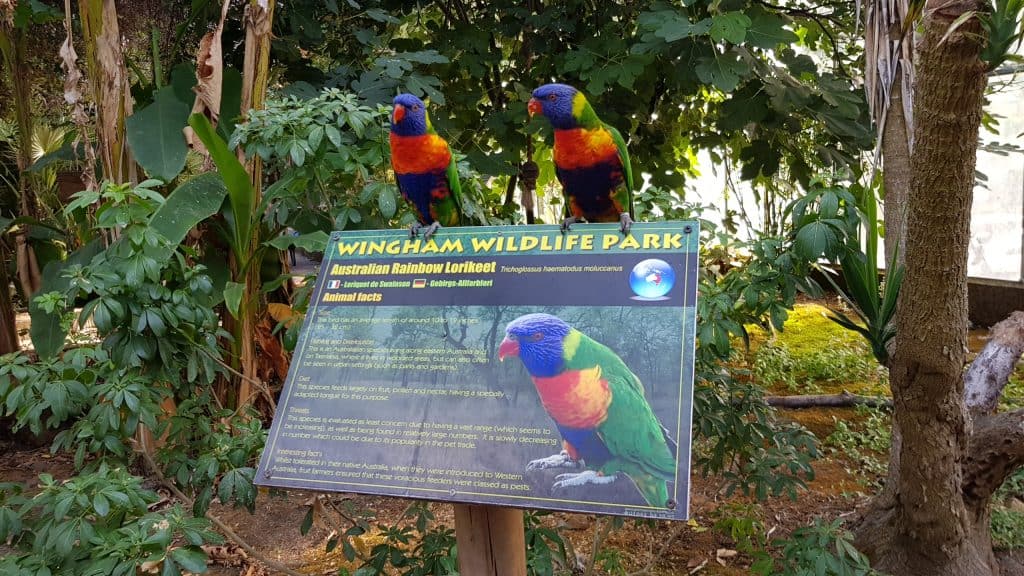Now the days are getting shorter and it’s getting a bit chilly, I find myself really enjoying my time in the Tropical House here at Wingham Wildlife Park. Not only is it an escape from the elements on a miserable day but you can’t help but smile at the main attraction in there… our group of Rainbow Lorikeets!
They never fail to put a smile on my face and I love watching their antics every day. They always seem like they’re having so much fun! So, prepare yourself for lots of Lorikeet spam now because as usual my blog this week is packed with photos and videos of this charismatic species.
It’s certainly not difficult to confuse these fun-loving parrots with any other species with those bright red bills and colourful feathers, as well as being one of the noisiest parrots we have here! They’re constantly chatting away to each other. There are over 50 species of Lorikeet globally. They are all medium-sized, noisy, and exceptionally colourful parrots of Australia and New Guinea.

Rainbow Lorikeets are widespread in eastern and northern Australia and have also been introduced to Perth which is thousands of kilometres away! There is also a small population in Tasmania which is also most likely an introduced population. They are mostly a coastal species in the wild and often found travelling around in loud fast-moving flocks.
When you enter our Tropical House you can see this way of living with our group of around 70 Lorikeets. However, in the wild thousands of birds can come together in communal roosts. I think they have a really funny sense of humour as the whole flock seem to love flying really fast past visitor’s heads which always causes a reaction! Maybe they have a little chuckle to themselves when they surprise someone? I love it, it’s so exciting to have them bomb right past you! Just amazing!
Rainbow Lorikeets are associated with a wide range of treed habitats. From rainforests to woodlands and mangroves and are quite adaptable as they also reside in well-treed urban areas as well. Despite their colourful appearance, it always surprises me how easily they can blend in. When you try to spot one in the trees it’s actually quite difficult! Their markings help to break up their outline making them superbly camouflaged in their environment. You can find out more about bird colouration in my blog here.

Their favourite time of day is feed time. They sure do get excited when they see us coming with breakfast and dinner. It’s easy to feel a bit mobbed with 70 odd Lorikeets waiting rather impatiently for their food whilst you try not to get pooped on. They often can’t wait and help themselves from the wheelbarrow! It’s super important that Lorikeets get a controlled/well balanced diet so please never bring your own food for the birds in the tropical house as this could make them sick.
In the wild Lorikeets spend a lot of time foraging on flowers to harvest nectar and pollen. However, they will also eat fruit, seeds and some insects. Here at the Park, we feed them a mixture of fruit, seeds and a special Lorry nectar which is specifically designed for Lorikeets. This contains all of those extra nutrients and minerals that they need. We also supplement their diet with tasty insect treats now and again. It’s fantastic watching the Lorikeets feeding as their tongue is perfectly designed for lapping up nectar. If you see them feeding make sure you try to get a good look at their brush-tipped tongues! I’ve not managed to get a good photo of this but you can just about make it out in my videos of them feeding above.
In the wild Rainbow Lorikeets lay their eggs in chewed, decayed wood, usually in the hollows of trees like eucalyptus. Here at the park, you might’ve noticed that we provide nest boxes for our Lorikeets to nest in. Inside we line the box with a covering of sawdust.
Once the chicks hatch we have to clean the boxes out twice a week to keep the boxes dry, otherwise mum and dad get a bit carried away and try to dry out the boxes with the chick’s own feathers which isn’t ideal! It’s certainly a perk of the job having a quick health check of these adorable chicks twice a week. Yes I said adorable chicks and not ugly as some of the other keepers insist! I don’t think there’s anything cuter than a bald little fluffball.


They sometimes have up to three eggs but usually lay just two eggs. When they both hatch the chicks cuddle up together in the nest. I find it fascinating watching the chick’s development. They grow up super-fast! After their initial fluffy stage, they seem to look less fluffy as they grow. After a couple of weeks you can start to see their pin feathers come through. My favourite stage is at around four weeks old when I think they start to take on the look of Sid the sloth from Ice Age.


By the time the chicks are around six to seven weeks old they pretty much have most of their adult-type feathers coming through, with the tail and wing feathers needing a bit more time to grow. The young leave the nest when they are around eight weeks old and they’re pretty easy to tell apart from the adults as their bills and eyes are very dark. Gradually over time the beak loses the dark colour and starts to turn orange/red and by one year old they achieve their full adult colours.
Mum and Dad seem to feed the chicks for a while after they leave the nest and it’s not long before we start seeing the newly fledged chicks joining the flock on the feed tables lapping up the nectar and tucking into their fruit.
Interestingly, both males and females look alike. So, to be sure of their gender they would need to be DNA tested by taking a feather sample.
Again, you can see in the video above how difficult it can be to see these youngsters in the foliage when they’re not making a racket! Very cryptic plumage despite being such colourful birds… and huge show-offs! But I think I’ve rambled on enough about my love for these entertaining little birds. I’ll leave you with a picture of our Lorikeets reading up about themselves. Or, perhaps they’re making sure visitors don’t miss what species they’re supposed to be?



